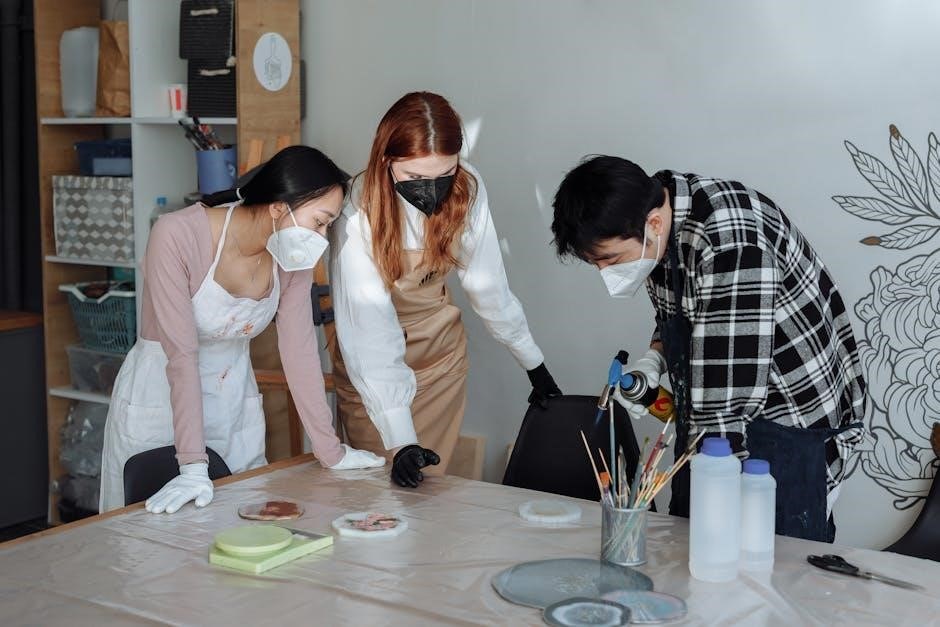
the making of asian america pdf
Erika Lee’s The Making of Asian America offers a comprehensive history, tracing Asian American experiences from early immigrants to modern-day communities, highlighting their profound impact on U․S․ society․
1․1 Overview of the Book
The Making of Asian America: A History by Erika Lee explores the rich, complex history of Asian Americans, spanning from early arrivals in the 16th century to modern-day communities․ The book examines the diverse experiences of various Asian groups, including Chinese, Japanese, Filipino, Korean, Vietnamese, and South Asian immigrants․ It highlights their contributions, challenges, and resilience, while addressing issues like exclusion laws, internment, and stereotypes․ Lee’s work fills gaps in historical narratives, offering a comprehensive understanding of Asian Americans’ roles in shaping U․S․ society and identity․
1․2 Author Erika Lee and Her Contributions
Erika Lee, a renowned historian and professor at Harvard University, has made significant contributions to the field of Asian American studies․ Her book, The Making of Asian America, is a seminal work that fills gaps in historical narratives by documenting the experiences of diverse Asian communities․ Lee’s research challenges stereotypes and sheds light on the complex struggles and achievements of Asian Americans․ As a leading scholar, she has reshaped understanding of immigration, race, and identity, earning acclaim for her meticulous scholarship and impactful storytelling․
1․3 Significance of the Book in Understanding Asian American History
The Making of Asian America is a groundbreaking work that provides a detailed and inclusive history of Asian Americans, addressing gaps in traditional narratives․ By examining the diverse experiences of various Asian groups, the book highlights their contributions to U․S․ society and challenges stereotypes․ It offers a nuanced understanding of immigration, race, and identity, making it an essential resource for comprehending the complex history of Asian Americans and their role in shaping the nation․

Historical Context of Asian Immigration to America
Asian immigration to America began with early sailors and traders, intensified during the Gold Rush, and continued with waves of Chinese, Japanese, and other groups, shaping U․S․ history;
2․1 Early Asian Presence in the Americas (Pre-19th Century)
The earliest Asian presence in the Americas dates back to the 1500s, with sailors and traders arriving on trans-Pacific ships․ These individuals, often from present-day China, Japan, and the Philippines, played roles as laborers, servants, and artisans․ Their presence laid the groundwork for later immigration waves, blending Asian cultures into the fabric of early American society․ This period marked the beginning of a complex and enduring Asian American history, shaping the foundation for future generations․ Their contributions, though often overlooked, were pivotal in the making of Asian America․
2․2 The Gold Rush and the Arrival of Chinese Immigrants
The California Gold Rush of 1848-1849 brought a wave of Chinese immigrants seeking economic opportunities․ They arrived in large numbers, attracted by the promise of wealth, but faced harsh conditions, racism, and exclusion․ Many Chinese miners were subjected to violence, forced out of mining areas, and denied rights․ The Foreign Miners’ Tax of 1850 specifically targeted them, further marginalizing their presence․ Despite these challenges, Chinese immigrants played a crucial role in shaping California’s economy and infrastructure, laying the groundwork for future Asian American communities․ Their resilience and contributions remain a cornerstone of this history․
2․3 Japanese, Filipino, and Korean Immigration in the Late 19th and Early 20th Centuries
During the late 19th and early 20th centuries, Japanese, Filipino, and Korean immigrants arrived in the U․S․, drawn by economic opportunities and fleeing political unrest․ Japanese immigrants worked in agriculture and established thriving communities, while Filipinos, under U․S․ colonial rule, came as laborers․ Koreans fled Japanese colonization, seeking refuge․ All three groups faced discrimination, exclusion laws, and restrictive policies․ Despite challenges, they contributed significantly to agriculture, labor movements, and cultural diversity, shaping the foundation of Asian America’s complex identity and resilience in the face of adversity․

The Making of Asian America: Key Themes
Erika Lee explores identity, exclusion, and resilience, highlighting how Asian Americans shaped U․S․ immigration policies, challenged stereotypes, and contributed to cultural and societal transformation in America․
3․1 The Concept of “Good Asians” vs․ “Bad Asians”
Erika Lee examines the dichotomy of “Good Asians” and “Bad Asians” in The Making of Asian America․ Historically, Asian immigrants were often categorized based on their perceived loyalty to America or their cultural assimilation․ “Good Asians” were seen as compliant and model minorities, while “Bad Asians” faced exclusion and discrimination․ This concept reflects broader racial and xenophobic attitudes in the U․S․, shaping policies and social perceptions that influenced Asian American communities for generations․ Lee argues this binary has persisted, affecting identity and belonging․
3․2 The Role of Asian Americans in Shaping U․S․ Immigration Policies
Erika Lee highlights how Asian Americans have influenced U․S․ immigration policies through activism and resilience․ From resisting exclusionary laws like the Chinese Exclusion Act to advocating for reforms, Asian Americans played a pivotal role in reshaping immigration frameworks․ Their efforts contributed to landmark legislation, such as the 1965 Immigration Act, which opened doors to diverse Asian populations․ By challenging discriminatory policies and advocating for inclusivity, Asian Americans have significantly impacted the evolution of U․S․ immigration laws, fostering a more equitable system for future generations․
3․3 The Impact of World War II on Asian American Communities
World War II profoundly shaped Asian American experiences, particularly for Japanese Americans, who faced mass incarceration in internment camps․ Despite this injustice, many Asian Americans contributed to the war effort, serving in the military and participating in home-front activities․ The war also shifted perceptions, with Chinese Americans gaining favor due to China’s alliance with the U․S․ However, the legacy of wartime discrimination and resilience continues to influence Asian American identity and their fight for justice and equality in post-war America․

Diverse Asian Communities in America
Asian America encompasses a rich tapestry of cultures, histories, and experiences, with diverse communities shaping the nation’s social, economic, and cultural fabric through resilience and contribution․
4․1 Chinese Americans: From Exclusion to Integration
Chinese Americans endured severe discrimination, including the 1882 Chinese Exclusion Act, which barred immigration and denied citizenship․ Despite facing violence, exclusion, and the Foreign Miners Tax, they persisted, contributing to industries like railroads and agriculture․ Their resilience laid the groundwork for eventual integration, as societal perceptions shifted during World War II, when China became a U․S․ ally, altering their status from “enemies” to valued members of American society․
4․2 Japanese Americans: Internment and Resilience
During World War II, Japanese Americans faced mass internment, with over 120,000 forcibly relocated to camps․ Despite harsh conditions, they maintained resilience, preserving cultural traditions and contributing to the war effort through military service․ The internment deeply impacted their lives, yet their strength and determination paved the way for post-war justice efforts, highlighting their enduring spirit and contributions to American society․
4․3 Filipino Americans: Identity and Contributions
Filipino Americans have navigated a complex identity shaped by colonial history, immigration, and cultural blending․ Their contributions span healthcare, cuisine, arts, and advocacy, enriching American society․ Filipino Americans have also played pivotal roles in social justice movements, advocating for labor rights and racial equality․ Despite historical challenges, their resilience and vibrant culture continue to thrive, making them a cornerstone of the Asian American experience and a testament to the diversity of the United States․
4․4 Korean Americans: Cultural and Economic Impact
Korean Americans have made significant cultural and economic contributions to the U․S․, from entrepreneurship to the arts․ Many have excelled in education and professions, fostering innovation․ The Korean American community has also enriched American culture through cuisine, music, and film, with K-pop and Korean BBQ gaining global popularity․ Their experiences reflect resilience and adaptation, blending Korean heritage with American life․ This duality has enabled Korean Americans to thrive, contributing to the nation’s economic growth and cultural diversity while preserving their unique identity and traditions․
4․5 Vietnamese Americans: Refugee Experiences and Adaptation
Vietnamese Americans, largely arriving as refugees after the Vietnam War, faced immense challenges adapting to a new homeland․ Many settled in areas like California and Texas, bringing rich cultural traditions․ Despite initial hardships, they established thriving communities through entrepreneurship, education, and community support․ Their resilience and determination have allowed Vietnamese Americans to flourish, contributing to the U․S․ economy and cultural tapestry while preserving their heritage․ This journey underscores their strength and the enduring impact of their experiences on shaping modern Asian America․
4․6 Hmong Americans: A Community in Transition
Hmong Americans, originally from Laos, Thailand, and China, began migrating to the U․S․ after the Vietnam War; Resettlement brought challenges like poverty and cultural adaptation, yet they maintained strong traditional values․ Community organizations played a vital role in preserving Hmong identity while fostering integration․ Their resilience is evident in thriving cultural practices, entrepreneurial ventures, and growing political engagement․ Despite historical marginalization, Hmong Americans continue to navigate their dual identities, contributing uniquely to the diverse tapestry of Asian America while honoring their heritage․
4․7 South Asian Americans: Diversity and Achievements
South Asian Americans, including Indians, Pakistanis, Bangladeshis, and Sri Lankans, bring vibrant diversity to Asian America․ Their contributions span technology, medicine, arts, and politics, with figures like Vice President Kamala Harris highlighting their growing influence․ Despite facing discrimination and identity challenges, South Asian Americans have thrived, blending cultural traditions with American life․ Their resilience and achievements underscore their integral role in shaping the nation’s multicultural landscape while maintaining a strong connection to their heritage․ Their stories reflect both struggle and triumph, enriching the broader Asian American experience․

Legal and Political Challenges Faced by Asian Americans
Asian Americans have historically faced exclusionary laws, citizenship denials, and racial discrimination, shaping their struggles for equality and justice in the U․S․ legal and political systems․
5․1 The Chinese Exclusion Act of 1882
The Chinese Exclusion Act of 1882 was the first U․S․ law to explicitly bar immigration based on nationality, targeting Chinese immigrants amid rising anti-Asian sentiment․ It suspended Chinese immigration for ten years and denied naturalization rights, reflecting widespread discrimination and xenophobia․ This law led to the mass expulsion of Chinese workers, violent attacks, and the erosion of their rights․ The act was renewed until its repeal in 1943, setting a precedent for future exclusionary policies aimed at Asian immigrants․ It remains a pivotal moment in Asian American legal history․
5․2 The Alien Land Laws and Their Impact
The Alien Land Laws, enacted in the early 20th century, primarily targeted Japanese immigrants by barring “aliens ineligible for citizenship” from owning land․ These laws, notably in California, were designed to restrict Asian immigrants’ economic opportunities and were rooted in racial discrimination․ Many Japanese farmers, who were central to the state’s agriculture, lost their livelihoods․ The laws symbolized the broader anti-Asian sentiment of the time and contributed to the marginalization of Asian communities, reinforcing exclusionary policies and racial segregation in the United States․
5․3 The Internment of Japanese Americans During World War II
During World War II, over 120,000 Japanese Americans were forcibly relocated and interned in camps under Executive Order 9066․ This action, driven by wartime hysteria and racial prejudice, resulted in the loss of homes, businesses, and livelihoods․ The internment highlighted the deep-seated xenophobia and fear of Asian Americans, as Japanese Americans were falsely accused of disloyalty․ Erika Lee’s work underscores the trauma and resilience of these communities, as well as the long-term impact on their identity and place in American society․

Stereotypes and Racism: Historical and Contemporary Issues
Asian Americans have long faced stereotypes, from the “model minority” myth to the “perpetual foreigner” trope, perpetuating systemic racism and cultural exclusion historically and today․
6․1 The “Model Minority” Stereotype

The “model minority” stereotype portrays Asian Americans as universally successful and compliant, masking the diversity and challenges within their communities․ This narrative, often contrasted with other minority groups, ignores historical and ongoing struggles such as discrimination, economic disparities, and cultural marginalization․ By perpetuating this myth, society overlooks the unique experiences of different Asian ethnic groups and their contributions․ The stereotype also fosters intra-racial tensions and pressures to conform, limiting opportunities for authentic representation and support․ Its impact remains deeply felt in education, employment, and social dynamics today․
6․2 Asian Americans and the “Perpetual Foreigner” Syndrome
Asian Americans often face the “perpetual foreigner” syndrome, a racialized belief that they are inherently outsiders, regardless of citizenship or birthplace․ This stereotype perpetuates exclusion and marginalization, as Asian Americans are frequently asked, “Where are you really from?” Historically rooted in xenophobic laws like the Chinese Exclusion Act, this mindset has persisted, fueling discrimination and microaggressions․ It denies Asian Americans their rightful place as integral members of American society, reinforcing their “otherness” and complicating their sense of belonging and identity; This syndrome remains a significant barrier to full inclusion and acceptance․
6․3 Modern-Day Racism and Xenophobia
Modern-day racism and xenophobia against Asian Americans persist through overt and subtle forms․ The COVID-19 pandemic exacerbated anti-Asian violence, with hate crimes surging as Asians were unfairly blamed․ Stereotypes, such as the “model minority” myth, mask systemic inequalities and divide communities․ Xenophobic policies and rhetoric further marginalize Asian immigrants, while microaggressions and workplace discrimination remain prevalent․ These issues highlight the ongoing struggle for Asian Americans to achieve true equity and representation in a society that often fails to recognize their full humanity and contributions․ solidarity and advocacy are crucial to combat these injustices․

Contributions of Asian Americans to American Society
Asian Americans have profoundly enriched U․S․ culture through food, arts, and entrepreneurship, while breaking barriers in politics and innovation, shaping a diverse and inclusive society․
7․1 Cultural Contributions: Food, Arts, and Literature
Asian Americans have profoundly enriched U․S․ culture through their culinary traditions, artistic expressions, and literary works․ From the popularity of Chinese, Japanese, and Korean cuisines to the vibrant contributions of Asian American artists and writers, their influence has created a cultural fusion․ Authors like Amy Tan and Maxine Hong Kingston have shaped American literature, while artists and filmmakers have brought diverse perspectives to the forefront․ This cultural exchange has not only preserved heritage but also fostered a more inclusive and dynamic American identity․
7․2 Economic Contributions: Entrepreneurship and Innovation
Asian Americans have been instrumental in driving U․S․ economic growth through entrepreneurship and innovation․ Many have founded successful businesses, from small family-owned enterprises to tech giants, creating jobs and stimulating local economies․ Their contributions span industries such as technology, healthcare, and hospitality․ Additionally, Asian Americans have played a crucial role in shaping U․S․ immigration policies, advocating for programs that attract skilled workers and foster innovation․ Their economic influence has not only strengthened the nation’s workforce but also paved the way for future generations of entrepreneurs and leaders․
7․3 Political Contributions: Emerging Asian American Leaders
Asian Americans are increasingly making their mark in U․S․ politics, with emerging leaders advocating for policies that reflect the community’s diverse needs․ From local offices to Congress, Asian American politicians are challenging stereotypes and broadening representation; Their leadership has been instrumental in shaping discussions on immigration, healthcare, and civil rights․ By amplifying underrepresented voices, these leaders are fostering inclusivity and inspiring future generations to engage in public service, ensuring that Asian American perspectives are integral to the nation’s political landscape․

Identity Formation and Community Building
Asian Americans navigate dual identities, blending cultural heritage with American experiences, fostering community through ethnic enclaves and shared traditions, while education plays a key role in shaping their unique identities․
8․1 The Role of Ethnic Enclaves in Preserving Culture
Ethnic enclaves, such as Chinatowns and Koreatowns, serve as cultural sanctuaries, preserving traditions, languages, and practices․ These communities provide a sense of belonging and continuity, fostering identity․ By maintaining cultural heritage, enclaves empower individuals to navigate their dual identities․ They also offer vibrant spaces for cultural expression, from food to festivals, ensuring Asian traditions thrive in America․ However, these enclaves face modern challenges, including gentrification and assimilation, testing their resilience in preserving cultural legacies for future generations․
8․2 Intergenerational Differences and Conflicts
Intergenerational differences among Asian Americans often stem from varying cultural values and adaptation to American life․ Older generations may prioritize traditional practices and family honor, while younger generations embrace Americanization․ Language barriers and differing expectations about education, careers, and marriage frequently lead to conflicts․ These tensions reflect broader struggles with identity and belonging․ Such generational gaps highlight the challenges of balancing cultural heritage with assimilation, shaping individual and collective identities within Asian American families and communities․ These dynamics underscore the complex process of navigating dual cultural worlds․
8․3 The Role of Education in Shaping Asian American Identity
Education plays a pivotal role in shaping Asian American identity by fostering cultural awareness and bridging generational gaps․ It provides a platform for exploring heritage while navigating American societal expectations․ Through educational experiences, Asian Americans often develop a sense of duality, balancing their cultural roots with their American upbringing․ This duality can lead to both personal growth and internal conflicts․ Education also serves as a tool for challenging stereotypes and promoting understanding, enabling Asian Americans to articulate their unique perspectives and contribute to a more inclusive society․ It empowers them to embrace their identity fully․

Contemporary Issues and the Future of Asian America
Asian Americans are increasingly influential in politics, media, and global affairs, addressing challenges like representation and inclusivity while shaping a dynamic, interconnected future for their communities․
9․1 The Rise of Asian Americans in Politics and Media
Asian Americans are gaining unprecedented visibility in politics and media, challenging stereotypes and fostering representation․ From elected officials to media personalities, their influence is growing, reflecting the community’s diversity and contributions․ This rise amplifies Asian American voices, addressing issues like inequality and identity, while inspiring future generations to engage in public service and creative fields, fostering a more inclusive society․
9․2 Challenges of Representation and Inclusivity
Despite progress, Asian Americans face challenges in achieving authentic representation and inclusivity․ Stereotypes persist in media, and political underrepresentation remains a barrier․ The community’s diversity often goes unacknowledged, leading to marginalization of certain groups․ Efforts to address these issues require systemic change, including increased opportunities in leadership roles and more nuanced portrayals in media․ Addressing these challenges is crucial for fostering a society where Asian Americans are fully seen and valued․
9․3 The Growing Influence of Asian America on Global Affairs
Asian Americans are increasingly shaping global affairs, leveraging their cultural and economic ties to bridge the U․S․ and Asia․ With rising political influence, figures like Kamala Harris and Andrew Yang highlight the community’s growing impact on foreign policy․ Asian American businesses and innovations are also reshaping international markets․ Cultural exports, such as K-pop and Bollywood, further amplify this influence․ However, challenges like stereotyping and balancing diverse identities within the community persist, complicating their global role․ Despite these hurdles, Asian America’s influence continues to expand, fostering global connections and understanding․
Leave a Reply
You must be logged in to post a comment.